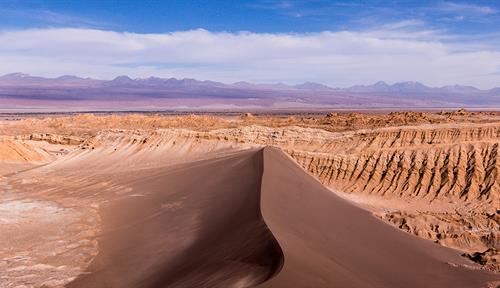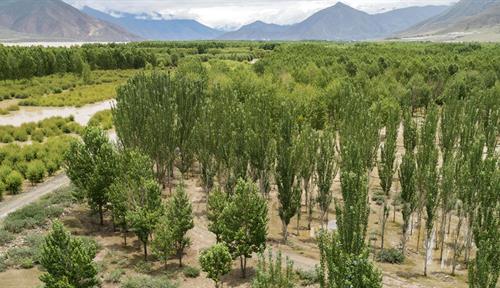Hunting sky islands for genetic clues to climate resilience
OPINION: Isolated mountaintops are hotbeds of evolutionary adaptation and great places to study how climate change affects ecosystems
Support sound science and smart stories
Help us make scientific knowledge accessible to all
Donate today
In Water Canyon, New Mexico, there is a small, 18-mile-long, high-elevation area called the Magdalena Mountains, surrounded by desert. The isolated peaks host a scrubby collection of plants, including a tiny cluster of about 20 cottonwood trees. They are trapped, as if on an island, unable to escape by migration or pollen flow across the surrounding inhospitable lowland to any faraway, or even nearby, high-elevation area.
It is one of the hottest and driest “sky island” sites that we study, far hotter than any adjacent large mountain chain, and a great place to look for climate-adapted traits.
As ecologists, we spend our time, alongside many great colleagues, in places like this across the western United States, hunting for features that have helped species to survive through more than 15,000 years of warming since the retreat of the last ice age. We work specifically in high-elevation cottonwood riparian forests in the western US: iconic ecosystems common to rivers in arid regions. Our hope is that the trees growing at these sites will give us insight into how we might protect against the effects of climate change.
Climate change is having a huge impact on the planet, and it is hard to predict what exactly it is going to do to complex ecosystems like forests. Our forests host leaf and soil microbial communities, mutualistic fungi, insects, mammals and more; together they shape the fertility of the soils, the quality of the water and the productivity of these ecosystems. That in turn shapes the availability of lumber and jobs, along with food security and global economies. Scientists are keen to learn how a changing climate and rising levels of carbon dioxide will affect these ecosystems, and to identify which gene variants, controlling which traits in which organisms, might help to impart resilience against these changes. Unfortunately, this is surprisingly hard to figure out.
Researchers have a few ways to tackle parts of this question. They can study ancient seeds or very old trees to get clues about how genetics relate to survival, for example. Sometimes they study how plants or animals differ at different elevations or latitudes. But these aren’t perfect analogs for climate change. Another approach is to study plants in a controlled area or a greenhouse, where the temperature, humidity and CO2 levels can be altered. But these studies are short-term and often small-scale.
We argue that great insight into long-term, climate-driven evolutionary change can be found by comparing sky islands to nearby mountain chains. Among populations living in mountain chains, natural selection is relatively relaxed, both because species can move around more, and because the climate is often milder in these larger blocs of terrain. Across the western US, sky islands are, on average, 35 percent warmer and receive 53 percent less precipitation than mountain chains. As a result, populations on sky islands face more potent pressure to evolve to deal with conditions that they cannot escape.
Sky islands are already hotbeds of diversification due to their isolation. In the Indian Western Ghats, for example, long-term isolation on sky islands has seen a bird called the white-bellied shortwing split into multiple taxonomic species. Though population divergence began almost 5 million years ago, modern climate change has accelerated such processes. For plants, one 12-year study in the Rocky Mountains found that plants on larger sky islands had shifted toward having smaller and denser leaves, which are better adapted for stress tolerance.
We and our colleagues have found that cottonwood trees in sky islands in the western US asexually clone themselves significantly more often, and produce less complex root systems, than do cottonwoods on adjacent mountain chains — adaptations that may help them to reproduce more quickly or get established under stressful conditions. These adaptations are seen in certain cottonwood tree clones initially found by our group, and the responsible regions of their genomes are being further investigated in our current work.
We have also found that the sky island soils have a unique composition of bacteria and fungi, different from those on nearby mountain chains. Some of our data from greenhouse studies suggest that the sky island microbial communities help to increase tree productivity.
Studies like these can help us to figure out the traits, and the genetic variants that underlie them, that contribute to survival under stressful conditions caused by climate change. And this is useful for predicting what might happen next to our ecosystems. It’s also a great way to find traits that we might use to help assist adaptation, or that work for the benefit of humanity. For example, companies are developing mixes of soil microbes that will help managed forests to grow faster and absorb more carbon from the air. Sky islands might be a great place to find such microbes.
The sky island story raises another concern: Many animals and plants on sky islands, including black bears, butterflies and owls, have small population sizes and less genetic diversity than larger populations elsewhere. They are under threat, but they must be preserved if we hope to uncover the trove of secrets that sky islands contain, to help us find ways for ecosystems to survive climate change.
At this time, there is only one organization, the Sky Island Alliance, dedicated to sky island conservation, with work focused in the Madrean Archipelago of the southwestern United States and northern Mexico. This work has spearheaded efforts to learn about and protect sky island species, and should be used to inform a broader global effort for sky island conservation.
10.1146/knowable-031124-1
TAKE A DEEPER DIVE | Explore Related Scholarly Articles






